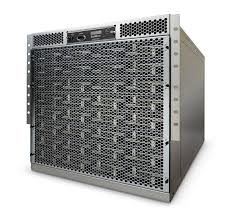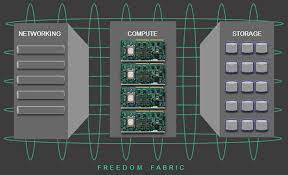AMD Evolving Fast to Survive in the Server Market Jungle
by Johan De Gelas on June 18, 2013 6:00 AM EST- Posted in
- AMD
- CPUs
- Arm
- Enterprise
Low Power Server CPUs
When you read about micro servers, the spotlights are on very low power servers with Atom and ARM servers. The reality in the server market is however very different. But as you probably understand from the reasoning above, a server with an Atom CPU or ARM CPU is hardly a good solution for the homogenous webfarms.
In fact, with the exception of Seamicro, many micro servers have utterly failed in that market. Quite a few server vendors have offered dense Atom based solutions, but those solutions were poorly received. Simply cramming tens of Atom based servers in a small chassis is a pretty bad idea:
1. The single threaded performance of the Atom is even for webfarms too low
2. The power gains that you make by using lower power CPUs are negated by the cable management costs, the higher amount of PCBs and PHYs.
To sum it up: the performance per watt of those servers did not and will not thrill anyone. Seamicro, the pioneer of this niche market, was successful despite and not thanks to the Atom processor inside it’s micro servers. When Seamicro offered Low Power Xeons instead of Atoms inside their Borg Cube inspired server, the demand for their products really took off.

And even Calxeda, the champion of the low power servers admits that the current “ultra low power but low performance” microserver market is a small one. Calxeda has high expectations for its next generation of servers as they will be based on the more powerful Cortex A15 and A57 CPUs.
Seamicro and Calxeda succeeded where others fails as they understood that an optimized PCB and network fabric was necessary to make the concept of micro server work. Seamicro reduced the serverboard to its bare minimum (“credit card size”), turned unnecessary features off and connected all I/O via a high performance 3D torus interconnect.

Calxeda integrated several servers on one PCB and connected them together with a 2D torus network fabric. The result was a low power draw per server, not just per CPU. Once you add a CPU with good enough single threaded performance, things get very interesting.










80 Comments
View All Comments
JohanAnandtech - Tuesday, June 18, 2013 - link
thx. fixed :-)Denithor - Tuesday, June 18, 2013 - link
"It is clear that the micro server market gets the lionshare of AMD’s attention."lion's share
"While the Opteron-X, Opteron 6300 and “Berlin” CPU will all face stiff completion from the Intel alternatives."
competition
"but it looks like Intel will probably have the upperhand in most traditional server markets."
upper hand
Wow, did you guys not edit this piece before going live?
JohanAnandtech - Tuesday, June 18, 2013 - link
To be honest, I wrongly assumed that I still had some time left, then discovered that the deadline was already a few hours ago and just hurried. So I humbly thank you for making this article more readable for our readers :-)JDG1980 - Tuesday, June 18, 2013 - link
I'm hoping we will see some relatively inexpensive Mini-ITX Kyoto boards. An Opteron-X paired with ECC RAM could make a good, reliable platform for a DIY firewall or low-end NAS.iwod - Tuesday, June 18, 2013 - link
I didn't known the 9W for X1150 was for 1Ghz Core. If so i guess Intel will have Zero competition for Atom Servers. Intel will want to get as much market shares between now to end of 2014 when ARM will have a low power server product. Seattle seems interesting, I wonder if it is possible to have 4x 16 Core Seattle in a server. Seems like a good candidate for Hosting environment.SuperMecha - Tuesday, June 18, 2013 - link
Remember that the X1150 has 4 cores vs the 2 for the Atom chip. It also has much better IPC and support for ECC and 32GB (DDR3-1600) of RAM vs only 8GB (DDR3-1333) for the S1260.JDG1980 - Tuesday, June 18, 2013 - link
The Centertron (S1200-series) Atoms already have ECC support. But the performance is still subpar, so AMD will have an advantage there. Also, as far as I have been able to determine, there is only one Centertron board available to DIYers (the Supermicro X9SBAA-F) and it's hard to find and quite pricey (>$250). If AMD could get Mini-ITX Kyoto boards out at the $150-$200 price point, this would be a quite attractive option for small servers.iwod - Tuesday, June 18, 2013 - link
So how would next Gen Intel Arch compared to Jaguar? Since Intel has ( I think ) Hyper Threading in their Next Gen as well, so a Dual Core isn't so far off from Quad Core, And it seems Intel can ups the Ghz a bit more then the X1150.I would love to see some comparison done.
milli - Tuesday, June 18, 2013 - link
"Berlin will use the same 28 nm process technology as the Opteron x1150 and x2150"Jaguar is made at TSMC.
Rumors for Steamroller derived processors point to production at Globalfoundries. Most go as far as claiming that it will be FD-SOI (see STMicroelectronics). That makes sense because 28nm bulk would be a step back compared to 32nm SOI. I don't think AMD is going to stop using SOI for their high-end CPU's anytime soon.
Either way, be sure that they won't be using the same process technology (even though they're both 28nm) for these very different CPU's.
rocketbuddha - Thursday, June 20, 2013 - link
Please...AMD specifically said in the DEC 2012 WSA amendment with Global Foundries. It is in Page 6 of the 11 Page PDF titles
<quote>
Separately, AMD will move to standard 28nm process technology and significantly reduce reimbursements to GF for future research and development costs.
–
We anticipate these savings will be approximately ~$20M per quarter during the next several years which also helps achieve our OPEX target of $450M by Q3 2013
<end quote>
Read again and again. The standard technology at 28nm is Bulk HKMG. not SOI.
Even GF's powerpoint roadmap states that the 20nm as well as 14XM process will both be successors to 28nm Bulk HKMG will continue to be Bulk HKMG and bulk with FinFETs respectively. And the SOI line stops with 28nm FD-SOI (in collaboration with STM) and just a ambiguous dotted line for the future.
With FDSOI we still do not know if GF has agreed to manufacture FDSOI parts in large volume. All we know is the license agreement between ST Micro and GF.